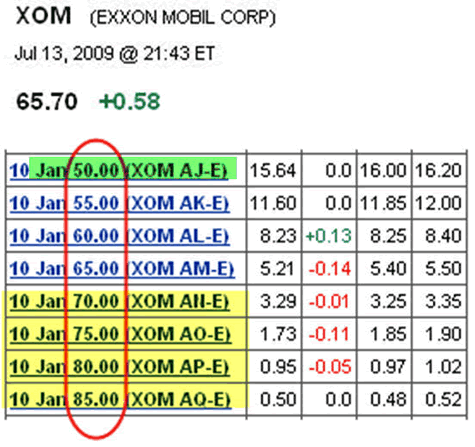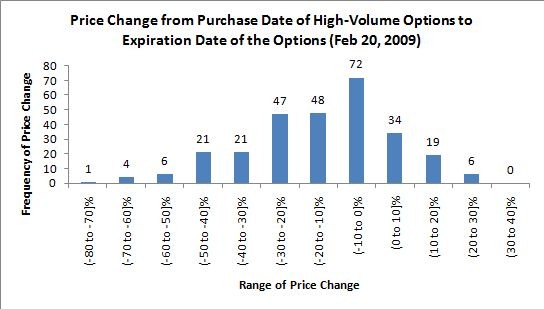Investment XYZ Put
Post on: 17 Май, 2015 No Comment

Friday, May 05, 2006
Put/Call Ratio: A Tea Leaf Indicator?
Investors love indicators, they give people some talking point for justifying their view. After all, if the stock market is a big random walk with 50/50 chance of going up and down, any indicators, including tea leaf and the cracks of turtle shell, can help pointing a direction and wouldn’t be terribly wrong.
www.cboe.com/data/PutCallRatio.aspx and the ISE Sentiment Indexwww.iseoptions.com/marketplace/statistics/sentiment_index.asp (ISE version ISEE is defined as call/put ratio, but here for comparison we will inverse it as put/call ratio). Put/call ratio is now taken as the most popular indicator for investor sentiment. High Put/Call ratio indicates bearish sentiment (more people buying puts), low indicates bullish. To add another twist, the so-called sentiment analysis theory would use this as contrarian indicator, bullish means bearish, bearish means bullish. Even the palm reader are not so smart in employing such contrarian dialectics.
Here I’m not going to discuss the contrarian part of the theory, but just look at the how true it is to infer put/call ratio as bull/bearish sentiment.
Let’s lay out some facts first.
When an option is traded, two sides of a contract is open: one side is long, one side short. Typically one side initiates the trade (either long or short) thus it takes the market (most of the time) — taking the market means buy on ask price, sell on bid price. The other would make the market — buy on bid (lower price) and sell on ask (higher price). That’s the price of liquidity: if you (typically the investors) take liquidity (initiate the trade), you have to pay for the bid/ask spread, while the passive side (the market makers who provide the liquidity) get to enjoy the bid/ask spread but have to do the trades whatever side the investors want. For investor sentiment, who should only for the side that initiate the trade, not the side that passively take the trade to provide liquidity.
Typically the initiated trades come from two types of people: 1) investors/speculators who use options as leverage tools to bet on stock direction; 2) proprietary traders who trade on mathematical models, or trade on a view on volatilities, dividends or interests. The first type of traders would not hedge away the delta since that’s the only factor they bet on, the second type would typically hedge away the delta and expose the residue risk on other dimensions such as vega (volatility), rho (interest rate) or dividends. On the passive side (the market makers), they always hedge away the delta.
When we take about bullish/bearish sentiment, it is always associate with delta (stock direction). Long delta = bullish; short delta = bearish. The investor bullish sentiment is associates with the following two strategies: 1) buy call (mostly take the price as ask); 2) sell put (mostly sell at the bid). Both are long delta. Conversely, the bearish sentiment is associated with 1) sell call (mostly take the price as bid); 2) buy put (mostly buy at the ask).
Thus the key to figure out the investor sentiment is in finding out how the investors (who bet on delta) initiate the trade (long or short).
There is some discount to the above sentiment relationship: if the trade is to close an existing position, then the strategy is for taking profit or cut loss, rather than a committed indication for bullish/bearish sign. For example, an investor initiates to sell a call he bought at lower price, he is taking profit rather than really indicate a bearish sentiment.
How can we recognize a trade as closing a position or truly initiated? You might think of open interest. but that won’t work. Even when the investor initiates a trade to close an existing position, the market may still need to open a new contract (thus increase the open interest), because the investor might had bought the original call from a different market maker, so that after the closing trade, the investor has no position, while one market maker has a short call, another has a long call.
Since there is no easy way to recognize a trade as closing or opening a position, we will just ignore this factor but at least we should keep in mind of such discounting factor.
To associate trading volume with bull/bear sentiment, we need to know:
1) The initiated side is investors/speculators, not proprietary traders.
2) Need to know a trade is done on the bid or ask price so that to determine the investor initiates to buy or sell.
Only the put/call ratio that is calculated using the subset of volume that satisfy both of the above two conditions would be a meaningful indicator for bull/bear sentiment.
The classic CBOE version of put/call ratio simply take the entire trading of volume of call and put into the calculation. ISE version trying to do a little better, excluding the volume initiated from broker/dealers, who are mostly likely to hedge delta. ISE version is close to satisfy the first condition above. We can indeed assume non-broker/dealer trades are all initiated by investors
However, ISE version includes only the Opening positions (which presumably means increase in open interest). As discussed above, open interest does not related to open/closing of investor positions. For now we would just ignore the distinction of open vs close trades, whether it is meant for actual positions or open interests.
My version of put/call ratio that would closely related to sentiment is:
Sentiment Ratio = (Put_Ask + Call_Bid) / (Call_Ask + Put_Bid)
Put_Ask (Call_Ask) is the investor volume of put (call) bought at ask price, Put_Bid (Call_Bid) is the investor volume of call sold at bid price.
The high this ratio, the more bearish the sentiment is.
Let’s put in some number and see a detail example. Supposed the total call trade volume is 10000 contracts, of which 4000 are from broker/dealers, put volume at 7000 contracts, of which 3500 are from broker/dealers. Of the portion attributed to investors, 3000 calls and 1000 put are initiated on ask price.
Total Call Trading Volume = 10000
Total Put Trading Volume = 7000
Non-Broker/Dealer Call Volume = 6000
- Traded on Ask Price = 4000
- Traded on Bid Price = 2000

Non-Broker/Dealer Put Volume = 3500
- Traded on Ask Price = 1000
- Traded on Bid Price = 1500
Here is what we would get for the three versions of put/call ratio:
CBOE version = 7000 /10000 = 0.7
ISE version = 3500 / 6000 = 0.58
My version = (1000 + 2000) / (2500 + 4000) = 0.46
The actual numbers here do not mean anything except just to show the wide range you can get.
The CBOE version would be just a statistics that may have certain meaning except it has little to do with sentiment. The ISE version is better in its exclusion of broker/dealer volume, but doesn’t mean the number is any close to the sentiment (or my version) — the rebalance of the volume traded on bid or offer can make ISE version as far away from truth as anything else (for example, if all the investor put volume comes from the selling on bid, the sentiment is totally opposite to attributing all these volumes to put buying). Thus improving a little in the quality of the data does not make the number any close to truth. Furthermore, to separate the broker/dealer volume out of the total volume, you need the option exchange to document and publish such distinction. That’s why ISE version include only the volume traded in ISE, one of the six option exchanges.
My version of put/call version is good on paper but pretty useless — presently there is no way to get these data from the option exchange or option data publisher (OPRA who distributes all the option pricing data).
So what can we learn from these ratios? Nothing. But that’s better than misleadingly associate them with something (like investor sentiment). Just like reading tea leaf to predict the future. There can be many theories on that, many people build a career on that, but the best way to deal with it is to know nothing about it.
That’s the whole point of this article — do not take the put/call ratio (as the available forms) as any indication of investor sentiment. Until we have a better categorization of trade volume data, it is better to have no indicator that to have a wrong one.
By the way, Doctor Jwww.cboe.com/tradtool/webcast.aspx ) is pretty good in gauging the investor sentiment on the individual stocks. Since he is trading in the option exchange, right on the frontline, he knows all about whether any big size trades happen on bid or ask prices, and that’s the way he uses to gauge whether the investors are bullish or bearish on a particular name — exactly the same principle I propose for the sentiment put/call ratio.
As for the contrarian theory (bullish sentiment means bearish future, simply put), maybe a contrarian on some wrong numbers will get it right? The magic of any stock prediction is usually you can get 50% right, which, unfortunately, many investors feel comfortable about that.
(The author can be contacted at huangxinw@gmail.com .)














